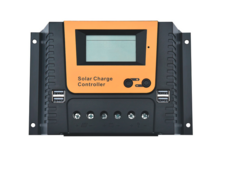D
Deleted member 91418
Guest
While I'm turned off by their products, that write-up is very informative!
They are around- multivoltage ones that can handle up to 48v battery banks like this one have a 100v PVmax rating...My system has been kept as basic as possible, since I've had a difficult time finding controllers that use ring terminals (my SUV goes down some of the worst roads in Canada.. and other fields). Not to go off the topic, but I am curious about something: wouldn't a panel with such a high voltage ruin a PWM the second it got power flowing through? I haven't seen too many PWM controllers capable of handling 40V+ panels (mine are limited to 38V arrays).


Yes...This article from victron is a great read, they produce both types pwm and mppt. You really cant make a generalization of "30% less".
Edit : "cant"
I currently have a Midnite Brat hooked up to 2 parallel Trina 335w panels that have a Vmp of 34v. Voc is not as important as Vmp as noted on the power curve. Match Vmp as close as possible to your charge voltage and you design your own efficiency into the setup. On my 24v system, (charging at 28.8v) its very efficient. I haven't noticed a difference from my Victron 100/30 that I removed. (Just an experiment)
You still get the same issue- you are throwing away anywhere from 25% to over 75% of your panels possible output power by staying with PWM over MPPT...I do like that! If those terminals were different, I wouldn't hesitate to jump for one.
You are comparing a low voltage parallel connected MPPT with a low voltage parallel connected PWM- most of the time your MPPT would have been running in PWM mode anyway (they really need about 5v minimum over the charging voltage before the MPPT circuitry kicks into life), and with your 34v Vmp and a 28.8v charging voltage- you only have 5.2v- for much of the morning before the peak, you would have been operating in PWM mode...This article from victron is a great read, they produce both types pwm and mppt. You really cant make a generalization of "30% less".
Edit : "cant"
I currently have a Midnite Brat hooked up to 2 parallel Trina 335w panels that have a Vmp of 34v. Voc is not as important as Vmp as noted on the power curve. Match Vmp as close as possible to your charge voltage and you design your own efficiency into the setup. On my 24v system, (charging at 28.8v) its very efficient. I haven't noticed a difference from my Victron 100/30 that I removed. (Just an experiment)
No they were series connected when using the victron.You are comparing a low voltage parallel connected MPPT with a low voltage parallel connected PWM- most of the time your MPPT would have been running in PWM mode anyway (they really need about 5v minimum over the charging voltage before the MPPT circuitry kicks into life), and with your 34v Vmp and a 28.8v charging voltage- you only have 5.2v- for much of the morning before the peak, you would have been operating in PWM mode...
so zero difference apart from a few hours in the middle of the day (maybe- depending on other factors like location , season etc, you may never get into MPPT mode all day...)
That is why it is important to try and get as close as possible to the PVmax rating (I prefer to leave a 20% margin for safety for those rare, but not that uncommon times when panels can briefly exceed their listed ratings by 10-15%)- so for my own 150v MPPTs for example, a series string that just under 120v is ideal...- the panels I selected here have a combined Voc of 114.7v with 3 in series- perfect...
And why I literally start charging at half an amp at sunrise, with no direct light on the panels at all...
Your low voltage PWM (or low voltage MPPT) won't start for an hour or two after that...
Exactly! Our office trailer's MPPTs begin charging when the sky is still feintly blue; my PWMs still need an hour (or two cups of coffee) before its signal lamps begin flickering.And why I literally start charging at half an amp at sunrise, with no direct light on the panels at all...
Your low voltage PWM (or low voltage MPPT) won't start for an hour or two after that...
You haven't seen Aussie outback roads- I drove a tilt-tray for several years after the mining boom collapsed here- and it wasn't uncommon for me to pick up both utes and caravans to take them home that had literally 'broken their backs' because of the corrugations on the dirt roads...But after having a Victron this past week not being able to hold up on horrible roads, I need a controller capable of holding cables down as tight as possible... such as ring terminals. I haven't found a single MPPT that uses ring terminals, therefore for my situation I am limited to PWM. Now I could just stick to smoother roads, but our job sites go on surfaces that make wash-boards look like a freshly-made piece of highway. If I was only doing campgrounds or Walmart parking lots, then I could see it making sense.
While I do support the fact MPPT is a lot more efficient than PWMs (I'm certain everyone does by now), It's common for my system to be fully topped-up before 1PM with PWM. For those with larger systems, however, I always say go for MPPT; it WILL make a huge difference in every aspect.



I've got a video of my panels charging the battery bank at the old campsite while I was building the shedExactly! Our office trailer's MPPTs begin charging when the sky is still feintly blue; my PWMs still need an hour (or two cups of coffee) before its signal lamps begin flickering.
That's exactly what happens in the office trailer.No visible sun at all, just running off the 'skyglow' you see just before dawn...
Not a lot obviously- a pulse of about half an amp once a second or so- you can see the voltage rising until the caps inside the charge controller are charged, then it dumps that into the battery bank and starts charging them up again...


